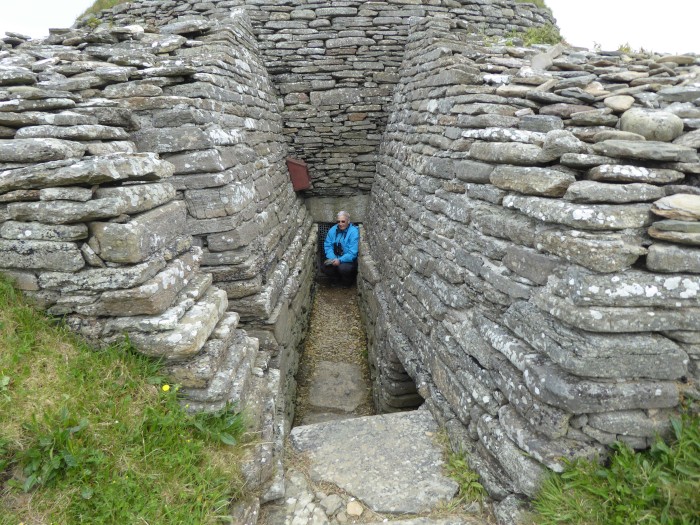Goodbye to the northern isles
21 June 2017

Our two final days in the northern islands were spent exploring Sanday further. We went back to the Quoyness cairn as the weather was overcast and much cooler the following day, and walked down a path walled off from any cattle. Go figure! For me the cairn was a disappointment, as the entrance passage was barely three feet high, and my flexibility is not what it was these days, so I did not go in. Ju braved it, however, and took some photos inside. Impressive, well restored and maintained. We had a conversation about how sites like this could do with the kind of body trolleys car mechanics use to get under vehicles.
Sanday has an excellent heritage centre, which covers the history of the island from earliest times. There was a section celebrating the life and work of Peter Maxwell Davies, Max as they called him, who lived on Sanday after he left his croft on Hoy, and died there only a few years ago. He did a huge amount of work with people in Orkney, making music and founding the St Magnus festival, which flourishes every year, attracting mainstream classical orchestras to the islands.
Our third day dawned sunny, so we headed back up to the bay with the beached destroyer, as low tide was early in the morning. I got some good photos of this amazing relic, still recognisable as a large ship, around 70 metres long, and very high up the beach.
Then we turned our attention to an interesting geographical feature of Sanday, high sand dunes, in a line down the edge of a wide sandy bay, with another wide sandy bay on the other side, culminating in an almost tidal island of a few acres, with farm buildings on it. In brilliant sunshine, with Jack off the lead, we walked down towards the houses by the farm. One of these, to our amazement, has just newly been built, in fact we saw a man still working on it. We could understand why someone would want to buld a house there, with a fantastic sea view and privacy guaranteed as the only access was by a four by four driving down a sandy and stony beach. More concerning is the pervasive erosion of the coastline here, as elsewhere on Orkney. The sandy beaches and cliffs of sand in the dunes are fast disappearing, so it could happen that these houses might end up literally isolated, on a new island! We found out later from our campsite owner that the man who owns the house made his money in the oil business.
On Thursday morning we headed down to the ferry, and enjoyed a smooth sail back down to Kirkwall, slightly sad as that was our last trip north to the islands from there.
On our way west we decided to look at two cairns signposted off the Kirkwall Stromness road, and headed to the top of the hill behind Kirkwall, Wideford Hill, covered in radio tv and mobile phone masts, with tremendous views of Scapa Flow, of Kirkwall, of many of the islands we had visited. The second cairn was nearer Finstown, and needed us to climb a hill to see. There were torches provided in a box for the intrepid visitor. Once again the access passage was tiny, so we let Jack have a look for us, helped by the beam of the torch. Then we climbed to the top of the hill and saw the interesting stone pillars which we suspect locals have built up in recent years, out of the ubiquitous flat Orkney stone, just to see how easy it is to construct things with.
A lunch at Leigh’s wonderful taste of Orkney lunch stall at Finstown, then off to Dounby for some supplies. Back at Birsay campsite we caught up with our laundry, and settled in for a few days rest and recreation before heading for Hoy on Sunday morning.
Finally we managed to cross the causeway and get on to the Brough of Birsay, with its interesting archaeological remains from nelithic and viking times. Discouraged by a rather old and battered notice banning dogs from the hill because of sheep, Ju and Jack stuck with the stones and I climbed up to the lighthouse. It was tiny, not very tapl, simly because it didn’t have to be. It sits on the top of high cliffs, so it can be seen for many miles around.



Comments